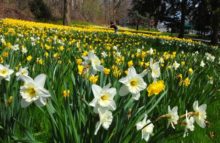My Rosa ‘New Dawn’ is not only beautiful, she’s a tough customer. I’ve written about her before. Not many climbing roses put on a show with about a half day of sun. She does.
But every couple of years at this time, when the buds show signs of life, she does need to be wrassled into order.
As I noted last year, 2009’s late-summer growing conditions were ideal for an abundance of new canes. Although I bent some to my will in early fall, many more shot off like fireworks in all directions and were waving at me this spring. The weather over Easter (this weekend, too) was a gift to g
ardeners, perfect for getting the arbour in shape.
Donning my well-worn rose glo
ves, I got started. Rose gloves are heavier cloth (or leather) long-sleeved gauntlets, and while they aren’t totally impervious to rose thorn pricks, they do protect your forearms from scratches. Well worth the investment.
Every rose wrangler needs sharp tools. My trusty (and rusty) old Felco #2 pruners are used for most cuts and, for thicker branches, I use telescoping loppers. Telescoping handles give you leverage when you need extra cutting power. Sharp tools mean clean cuts and minimal stem damage. We give you tips on sharpening pruners here.
Before you tie in new rose canes, you need to make room by removing old canes. Pruning an established rose on an arbour can be like untangling a necklace. Your eye needs to follow each cane from its base to the tangle of small flowering branches.
Begin inside the arbour. Remove any canes that are growing inward and obstructing traffic. Flowering stems growing into the arbour will also be shaded and, therefore, not as productive.
Shorten canes to
a bud that grows in the direction you want the cane to continue. Rosarian purists recommend disinfecting pruner blades with a weak bleach solution between cuts. I have never done this to my 20-year-old ‘New Dawn’ and she continues to flourish. Touch rosewood.
If the cane you want to remove is tangled with others, remove it in sections. Avoid dragging thorns across other canes, which will damage the bark.
 Cut without leaving a stump, not even a small one. Without leaves at the end, stump tissue dies and leaves the stem open to disease. Cut cleanly and closely, near the collar (or raised area) at the stem base. See the two before and after pictures at right.
Cut without leaving a stump, not even a small one. Without leaves at the end, stump tissue dies and leaves the stem open to disease. Cut cleanly and closely, near the collar (or raised area) at the stem base. See the two before and after pictures at right.
Once inward-growing canes are under control, look at the health of the bark of older stems. Remove stems or tips that look winter-burned (they’ll look dry and brown) down to a bud with living tissue, or right to the base. If in doubt, scrape a little bark off on the suspect section with your fingernail. If you don’t see green, it’s dead.
Weak or thin stems can also go – by this, I don’t mean the multi-branched flowering stems near the ends, but any puny longer canes. Usually, you’ll find that the stems you’ve removed are older. Try not to remove more than one-third of the older stems in any one year.
One of the easiest ways to prune a rose is to prevent an unwanted branch from developing by bud pruning. This simply involves rubbing or gently scraping off any buds that are growing in the wrong direction – such as towards the interior of the arbour.
At right, you can see before and after shots of the bud pruning technique, though I can see now that I could have done it a little more neatly. You can see that I’ve left a small tag of the bud, which should have been removed. Rose pruning also good for roses you’re training on a wall or obeslik.
(You can do this for rugosas and other shrub roses too, but watch out for small thorns.)
 Finally, you have space to tie in your new rose canes. To produce the greatest number of floweri
Finally, you have space to tie in your new rose canes. To produce the greatest number of floweri
ng stems, tie them as horizontally as possible. On the sides of the arbour, if the canes are still supple in the fall, you can try to train them in an S-shape. Often they’re too woody to do this come spring. If you’re wall-training your rose, fan the canes out widely. Buds on these horizontal canes will want to grow upward, each with flowering stems at the end. At the top of the arbour, loop canes across in a broad arc. Don’t stress, as there always seems to be “one that got away.”
Have fun, and enjoy your roses. Mistakes are not too serious in most cases. As my three-year-old daughter once reminded me after her brother had cut off all and I mean all her hair playing barber: Don’t cry, Mummy. I’ll grow.











11 comments
A fabulous How-to for all of us who are a little timid when it comes to pruning a climber. I'm always afraid if I go too far, I won't have any blooms. Thanks for the tips.
I did my 'New Dawn' a few years ago. It is not a task I look forward to, but she is certainly worth it!
Your advice is timely. Next month, I will be planting my first climbing rose bush ever. Thanks for the pruning tips.
And – did her hair grow out OK?
A very informative and reassuring post. Love the rose gloves!
Heather, There's nothing like doing for learning. There are some excellent pruning books out there if you're feeling gun shy. I have the Cavendish Encyclopedia of Pruning and Training by Christopher Brickell, which has excellent images for guidance.
Sheila, I used to prune 'New Dawn' every year, but realized that it takes a couple of years for the new growth to properly settle in. Last year was a bounty of bloom, but the downside is a much more tangled arbour. In fact, the arbour's so heavily laden, it's starting to list to one side.
Allan, I find it hard to believe that you haven't had a climbing rose in your garden history. Glad to contribute to the knowledge store.
Diana, Yes, eventually, her hair did grow out okay — though for a few months she looked like one of those WW2 French collaborators. He cut it right to the scalp, with just little tufts left here and there. Now, she's a beautiful 23-year-old, with all her lovely hair intact.
Ms. S., Wanted to be reassuring because, really, it's not that complicated once you know how. Rose gloves you gotta have.
Wendy, Bud pruning deserves a post all on its own, it's such a great tip. Enjoy your roses!
This is good information Helen. In my zone 2 garden winterkill told me what canes to prune so I just followed mother natures advice. This seems to be partly true in my zone 3 garden too. I laughed when I read the part about you son cutting his sisters hair 🙂
This is one of three roses I have! Not Dead Yet New Dawn is lovely….Thanks for the help in learning to prune. gail
No roses in my garden. I have never had luck with them for some reason. My grandmother is probably turning in her grave over the thought that her only grand daughter is not growing any when she had such a lovely rose garden…
I think I need you here for some hands-on advice on my New Dawn roses. OMG, if someone had told me what beasts they are before I planted them, I would have planned better.
I'll try to follow your advice. But I really think I need professional help.
Oh my! That first photo looked so intimidating – thanks for the great advice!